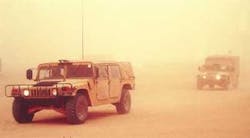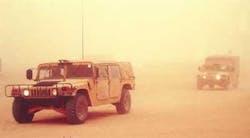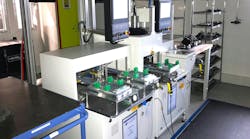Communications equipment
Army Special Forces settles on KVH TACNAV navigation system
U.S. Army Special Forces commanders needed vehicular navigation systems for demanding environmental conditions. They found their solution in the TACNAV Light system from KVH Industries Inc. in Middletown, R.I.
Army Special Forces Command (SOCOM) certified that TACNAV Light has achieved Milestone C, authorizing the system for full-rate production and fielding aboard Army SOCOM vehicles.
Army leaders also approved TACNAV Light as a standard Army system, and designated the unit "M100 Ground Mobility Enhanced Navigation System (M100 GMENS)." The system blends a global positioning system (GPS) receiver with inertial and magnetic field sensors, which makes the unit extremely difficult to jam.
During the second Persian Gulf War of 2003, Iraqi military forces tried to jam GPS systems, and sandstorms reduced visibility to near zero. TACNAV was designed with situations like this in mind, KVH officials say.
Leaders of the U.S. Army and Marine Corps, as well as many allied countries such as Canada, Sweden, the United Kingdom, Spain, Australia, New Zealand, and Italy, have fielded TACNAV units.
For more information contact KVH by phone at 401-847-3327, by fax at 401-849-0045, by post at 50 Enterprise Center, Middletown RI 02842, or online at www.kvh.com.
Computer peripherals
L-3 division chooses GPS receivers from CMC
Systems integrators at the Aviation Communication & Surveillance Systems (ACSS) in Phoenix — an activity of L-3 Communications and Thales Co. — needed global positioning system (GPS) receivers for the new ACSS terrain and traffic collision avoidance system. They found their solution from CMC Electronics Inc. in Ville Saint-Laurent, Quebec.
The ACSS CMA-4024 system, familiarly known as the T2CAS, has received U.S. Federal Aviation Administration (FAA) certification. The CMA-4024 received FAA TSO-C129a certification for functional requirements, and complies with DO-178B level B software-development guidelines. The device also meets the complex electronic hardware development guidelines of DO-254 level B.
The CMA-4024 is a 24-channel aviation-grade receiver with a growth path to Wide Area Augmentation System/Ground Based Augmentation System precision approach and automatic landing capability, CMC officials say.
"We selected the CMC Electronics GPS receiver based on its technical capabilities and because of CMC's extensive GPS experience and long-standing reputation for producing highly reliable avionics products," says Joe Hoffman, president of ACSS.
T2CAS is a safety avionics system that combines an aircraft performance-based terrain-avoidance warning system, and a GPS receiver in one line-replaceable unit.
For more information contact CMC Electronics by phone at 514-748-3148, by fax at 514-748-3100, by post at 600 Dr. Frederik Philips Blvd., Ville Saint-Laurent, Quebec, Canada, H4M 2S9, or online at www.cmcelectronics.ca.
Sensors
South African aeronautics company chooses BAE Systems sensor for UAV
Unmanned aerial vehicle designers from Advanced Technologies & Engineering Co. Ltd. in South Africa needed inertial measurement units (IMUs) for the Unmanned Aerial Observation System tactical aircraft that they are building for the South African army. They found their solution from BAE Systems Inertial Products in Johnson City, N.Y.
Designers from Advanced Technologies & Engineering — better known as ATE — chose the BAE Systems SiIMU silicon micromachined electromechanical IMU for the South African UAV's autopilot and strapdown inertial navigation system. The South African army is using the UAOS tactical aircraft to support artillery units in target geolocation, fall-of-shot detection, and fire correction.
The SiIMU sensor uses silicon micromachined ring-gyroscope technology to create a fully compensated six-degree-of-freedom rate and linear-acceleration measurement unit. This sensor is part of the U.S. Navy Extended Range Guided Munition, U.S. Army Advanced Precision Kill Weapon System, and the United Kingdom next-generation shoulder-launched anti-tank missile called MBT-LAW.
BAE Systems Inertial Products is part of the BAE Systems Platform Systems division. For more information contact the company by phone at 607-770-2000, by fax at 607-770-3524, by post at 600 Main St., Johnson City, NY 13790, or online at www.ps.na.baesystems.com.
Board products
U.S. Navy chooses air-control radar boards from Primagraphics
Systems integrators at the U.S. Naval Air Warfare Center (NAWC) Aircraft Division at Patuxent River Naval Air Station, Md., needed circuit cards to support Navy air-traffic-control consoles. They found their solution from Primagraphics Ltd. of Litlington, England. They awarded Primagraphics a contract to supply commercial off-the-shelf (COTS) circuit cards on Navy aircraft carriers and amphibious assault ships NAWC experts will integrate the equipment into the air-traffic-control consoles that help control helicopters and fixed-wing aircraft during operations at sea.
Primagraphics will supply the Navy with EVME-based graphics display controllers with 2,048-by-2,048-pixel resolution to generate combined graphics, radar, and video images on flat-panel displays aboard the ships. Primagraphics will also supply the Navy with radar-scan converters and radar-acquisition circuit cards.
Primagraphics hardware will include the Virgo radar-acquisition card, the 2k Vantage radar-scan converter, and the 2k Tiger graphics-display controller.
For more information contact Primagraphics by phone at 011-44-1763-852222, by fax at 011-44-1763-853324, by e-mail at [email protected], by post at New Cambridge House, Litlington, Nr. Royston, Herts, SG8 0SS, England, or online at www.primagraphics.net.
Computers
Dolch NotePAC rugged notebook computers pass battlefield test in Iraq
U.S. soldiers fighting in the second Persian Gulf War of 2003 needed extremely rugged notebook computers for administrative tasks and for filing news stories from the battlefield. The NotePAC rugged computer from Dolch Computer Systems Inc. in Fremont, Calif., met their needs.
"The computer worked perfectly when I was in the desert, which gave this war correspondent a degree of peace of mind not easily obtainable under fire," says Bob Ackerman, editor and chief of Signal magazine, who was embedded with the U.S. Army 101st Airborne division. "This rugged laptop was the envy of almost everyone in the 101st. "Many soldiers asked to see the machine that they had heard about form their friends, and they expressed the desire to have one.
As a mobile communications device, the NotePAC enabled embedded members of the media to report battlefield information in real time as it unfolded, Linked with a satellite communications system, reporters were able to transmit data, audio, and graphics to accomplish immediate publication of their reports, Dolch officials say.
The NotePAC is sealed from intrusion by water, salt-laden air, and blowing dust and sand, company officials say. It has a strong cast-magnesium case and shock-mounted components to form a portable platform that can withstand a 15-g operating shock load and a 50-g nonoperating shock load. The computer also can operate continuously in high-vibration environments such as helicopters and off-road vehicles, Dolch officials say.
For more information contact Dolch by phone at 877-347-4938, by post at 3178 Laurelview Court, Fremont, CA 94538, or online at www.dolch.com.
Displays
Lockheed Martin chooses VSI for F-35 helmet-mounted display
Aircraft systems designers at the Lockheed Martin Aeronautics Co. in Fort Worth, Texas, needed a helmet-mounted display for the future joint-services F-35 Joint Strike Fighter. They found their solution from Vision Systems International LLC (VSI) of San Jose, Calif.
VSI is a joint venture between EFW Inc, a subsidiary of Elbit Systems Ltd. and Rockwell Collins, formed in 1996 to pursue helmet-mounted display technology. Its experts will develop and deliver helmet-mounted displays for the F-35 and integration laboratories, as well as for F-35 flight simulators and flight-test aircraft.
The latest contract with VSI covers the F-35 system development and demonstration phase, and planning for low-rate initial production and subsequent full-rate production. VSI officials say they expect to build as many as 3,000 helmet-mounted displays for F-35 aircraft, laboratories, and flight simulators.
For more information contact VSI by phone at 408-433-9720, by fax at 408-432-8449, by post at 641 River Oaks Parkway, San Jose, CA 95134, or online at www.vsi-hmcs.com.
Components
Canadian research satellite uses retroreflectors from PLX
Satellite designers at ABB Bomem of Quebec City needed retroreflectors for the Atmospheric Chemistry Experiment Fourier Transform Spectrometer (ACE-FTS) that ABB built for the Canadian Space Agency. They found their solution from PLX Inc. of Deer Park, N.Y.
PLX officials are providing their space-qualfied hollow retroreflectors for satellite-borne Fourier-transform spectrometers to ABB Bomem for the ACE-FTS. The ACE-FTS launched into space from Vandenberg Air Force Base, Calif., in early August. The ACE-FTS is part of the scientific payload of the Canadian Scientific Satellite Mission. The Canadian space research will measure the chemical processes that control the distribution of ozone in Earth's atmosphere.
PLX retroreflectors provide modulation in the ACE-FTS, which is a Michelson interferometer. PLX-designed mounts enable these retroreflectors to withstand launch vibration, temperature extremes, and high acceleration.
For more information contact PLX by phone at 631-586-4190, by fax at 631-586-4196, by e-mail at [email protected], by post at 40 West Jefryn Blvd., Deer Park, NY 11729, or online at www.plxinc.com.
Test & measurement equipment
Navy and EDS Web experts use Securify software to monitor networks
Network information specialists from Electronic Data Systems Corp. (EDS) in Plano, Texas, needed network-monitoring software to alert operators of suspicious use of U.S. Navy computer networks. The SecurVantage software from Securify Inc. in Mountain View, Calif., met their needs.
EDS is using the SecurVantage software to help secure relatively old Navy networks during the Navy Department's switch to the Navy Marine Corps Intranet. The security-management software will be used to verify the policy compliance of the Navy networks and provide the metrics necessary to manage the overall security posture of the NMCI and old Navy networks, Securify officials say.
For more information contact Security by phone at 650-812-9400, by fax at 650-812-9401, by post at 1157 San Antonio Road, Mountain View, CA 94043, or online at www.securify.com.




